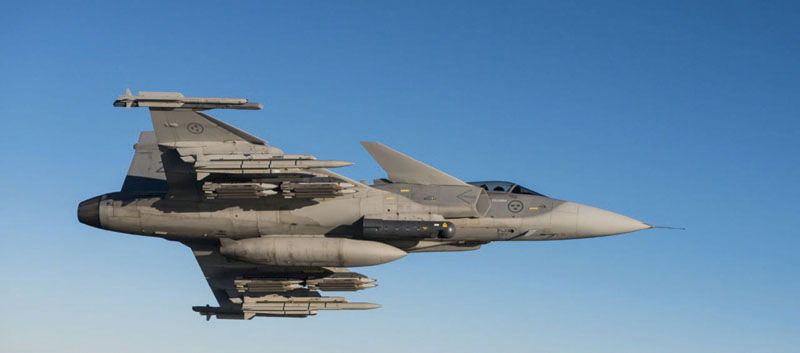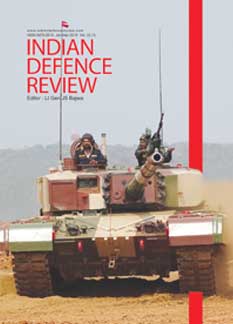F-16 Block 70
The F-16 Block 70 builds on the basic super successful combat aircraft introducing new technologies with improved radar systems, advanced weapons capabilities and enhanced battle-space awareness. On offer is Northrop Grumman’s advanced APG-83 Active Electronically Scanned Array (AESA) radar, a new avionics architecture and structural upgrades to extend the structural life by more than 50 per cent.
While Americans have greater power to arm-twist India or put restrictions, they critically need India in their Asia-Pacific pivot strategy…
The APG-83 provides high quality target area detail and digital map displays that can be tailored with slew and zoom features. It provides fifth generation fighter radar capabilities by leveraging hardware and software commonality with F-22 and F-35 AESA radars.
Operational capabilities are enhanced through an advanced data-link, targeting pod and weapons, precision GPS navigation and the Auto GCAS. The system is currently also being integrated into the US Air Force’s F-16 fleet and similar systems being developed for the F-22 and F-35. Lockheed Martin has certified more than 3,300 carriage and release configurations for greater that 180 weapon and store types. The new Center Pedestal Display (CPD) provides high-resolution color display of AESA and targeting pod data. The CPD is also compatible with the Night Vision Imaging System. The F-16 remains the world’s most successful, combat-proven multi-role fighter ever produced, and the F-16 Block 70 is the newest and most technologically advanced F-16 ever offered.
The F-16 ‘Block 70/72’ is being offered exclusively for India under the ‘Make-in-India’ programme. The proposal would give India partial control along with the US over which countries are able to purchase F-16 fighter jets and spare parts. If India were to select the F-16, it would become the sixth country to build the aircraft. The PAF operates nearly 100 F-16s. Bulk of the Pakistani fleet consists of Turkey upgraded Block 52 standard. It also has 18 F-16C/D Block 50/52 planes. Pakistan is worried that F-16 production shift to India will have implications for it. US may coordinate their product support through Turkey.
The F-16 can be called a ‘modern day MiG-21’ in terms of success and huge world-wide sales…
Lockheed Martin and India
Lockheed Martin has been in India for more than 25 years. Lockheed Martin is the pre-eminent designer, developer and manufacturer of the world’s most advanced fighter aircraft such as the F-22 and F-35. They have a partnership and Joint Venture company with Tata Advanced Systems Limited (TASL) where airframe components for the C-130J airlifter and the S-92 helicopter are manufactured in India. It is a partnership between the world’s largest defence contractor and India’s premier industrial house. That gives the company a headstart in terms of ‘Make-in-India’ presence. The two companies have signed a landmark agreement with intent to join hands to produce the F-16 Block 70 in India to meet the IAF’s single-engine fighter needs. It will provide India the opportunity to produce, operate and export F-16 Block 70 aircraft. F-16 production in India would support thousands of Lockheed Martin and F-16 supplier jobs in the US, and create new manufacturing jobs in India, and position Indian industry at the centre of the most extensive fighter aircraft supply ecosystem in the world.
Saab JAS 39 E/F Gripen
JAS 39 Gripen first flew in December 1988. On that count it came 14 years later than the F-16. The 250 aircraft built are flying in Sweden, Czech Republic, Hungary, Brazil, South Africa and Thailand. The aircraft has been sourced roughly 67 per cent from Swedish or European suppliers and 33 per cent from the US. The JAS 39 E and F variants have adopted the less expensive F414G power-plant vis-à-vis the Eurojet EJ200. All operators also have access to the Gripen’s source code and technical documentation, allowing for upgrades and new equipment to be independently integrated. On offer to India initially was the Next Generation (NG) version of the Saab JAS 39 E/F Gripen with more powerful power-plant (EJ-200), new avionics and AESA radar.
On offer to India initially was the Next Generation (NG) version of the Saab JAS 39 E/F Gripen with more powerful power-plant (EJ-200), new avionics and AESA radar…
In September 2015, Saab announced that an Electronic Warfare (EW) version of the Gripen F two-seater was under development. The aircraft cost was around $60 million. The Swedish Armed Forces plan to maintain 100 C/D-model aircraft until 2042. The first Gripen E was rolled out on May 18, 2016. Sweden plans to order the Gripen NG, designated JAS 39E/F, that will enter service in 2018, and the cost will reduce only in case of export orders. SAAB proposed significant Transfer of Technology and to make India ‘an independent manufacturer’ of the fighter jets. The potential customers include Botswana, Brazil, Colombia, Croatia, Finland, Indonesia, Poland, Slovakia and Switzerland. In a proposal that has the backing of the Swedish government, Sweden has strategically offered to collaborate with the Adani group, who will be its production partner in India, to use their muscle to bid for the Gripen sale.
SAAB in India
Saab has been a supplier to the Indian armed forces for over three decades. In 1974, India acquired Saab Carl Gustav Anti Tank System. In 1978, Saab 37 Viggen was a competitor for the IAF’s Deep Penetration Strike Aircraft (DPSA) eventually won by SEPECAT Jaguar. In 2002, Carl Gustav Anti Tank System was upgraded. At Aero India 2005, for the first time the Gripen was displayed. In 2007, Saab set up office in India. In 2008, Saab offered Gripen to the IAF. In 2008, Saab received production orders from HAL for the Integrated Defensive Aids Suite (IDAS) for the Indian Advanced Light Helicopter (ALH). In 2009, Saab signed an Agreement with QuEST Global for supply of machined parts. In 2010, Saab signed an MoU with Samtel to jointly develop, manufacture and market the RIGS Head-Up Display. Saab has a contract with CIM Tools Pvt. Ltd. (Bengaluru) for the manufacture of machined components for the Boeing 787.
Saab has an order from the Directorate General of Lighthouses and Lightships (DGLL) for a Coastal Surveillance System. Saab and BEL also have tie-ups for enhancing India’s Coastal Surveillance systems. In 2011, Saab and Mahindra announce a strategic agreement to establish the Saab India Technology Centre in Hyderabad. Saab has a tie-up with Wipro for the development of Saab’s LEDS. In 2012, Saab and Pipavav Offshore and Defence Engineering Ltd. jointly announce forming of a group called Combat System Engineering Group (CSEG). Later Saab acquired 3.33 per cent stake in Pipavav.
Both aircraft have already been technically evaluated to great extent during MMRCA trials…
In 2013, Saab received first order from HAL for the serial production of an integrated electronic warfare self-protection system for installation on the Indian Army’s and IAF’s Advanced Light Helicopter. In 2013, Saab and Quest inaugurated the Aero-structures Assemblies India Pvt. Ltd. (AAI) facility at Belgaum. Saab and the Kalyani Group has a strategic alliance to partner for Indian Army air defence projects, including the VSHORAD and SRSAM requirements. Saab and Ashok Leyland have teamed up to provide the Saab SRSAM BAMSE missile system with Ashok Leyland high-mobility vehicles. In 2014, Saab and AAI rolled out the first batch of A-380 structural assemblies from their facility in Belgaum. In 2015, Saab received follow-on orders for the ALH’s EW System. Saab has offered a fighter sensor package for the Tejas LCA Mk1A. The package consists of a state-of-the-art Saab AESA fighter radar closely integrated with a compact electronic warfare suite using Gallium Nitride-based AESA technology.
Decision Matrix India
Both aircraft have already been technically evaluated to a great extent during MMRCA trials. In the absence of a formal Request for Proposal (RfP), numbers required and technical requirements are still not clear. Whether the government will follow the standard time-consuming DPP procurement approach or fast track through government-to-government contract, still has to evolve. Cost, extent of technology transfer and support in setting up production facilities will be a key factor for selection. India will also have to take a call on the liabilities for servicing older customers that will shift along with exclusive production line. All these aircraft have gone through major airframe, engine and avionics upgrades over the years. Effectively, the aircraft can be called of current vintage.
Saab has already offered the latest Gallium Nitrate AESA technology without any strings or restrictions. The US has still to offer full AESA technology. Having failed in developing the Kaveri engine, India desperately needs aircraft engine technology. Gripen NG has high reliance on US-supplied hardware, including electronics, weaponry and the GE F414 engine, as a factor that may hamper its ability to be exported. There are little over 200 Gripen in service with various military users. This would mean a very small market for India.
Whichever aircraft India chooses, must carry on for at least 40 years without technological obsolescence…
While on the one side, India will always be able to deal from a position of strength with Sweden, on the other, Sweden has little leverage to support India in any international forum. While Americans have greater power to arm-twist India or put restrictions, they critically need India in their Asia-Pacific pivot strategy. India can take advantage of this. A large number of fighter aircraft around the world are using American engines. The GE-414 would bring commonality with LCA Mk II. India has already indicated this to USA under the bilateral Defense Technology and Trade Initiative (DTTI).
Internationally, 300 aircraft is a cost-effective production line to set-up. Whichever aircraft India chooses, must carry on for at least 40 years without technological obsolescence. But we may still be dependent on a US firm for the engine. The Logistics Exchange Memorandum of Agreement (LEMOA) has already been signed and more agreements will follow. India needs military might as a deterrent for a possible two-front war threat by the China and Pakistan combine. The IAF awaits early completion of the process.







Tough decisions for the IAF and the Govt bearing in mind what the foreign governments will allow?
If F-16 will pave way for F-35 better India make 126 F-16 with 100% TOT followed by 126 Tejas-II and induct 100 F-35 before 2030. INS Vikramaditya and INS Vikrant should also fly F-35B from its deck along with Mig-29Ks and INS Vishal should field F-35C in future.
I don’t think F35 is a good option instead we wait for PAKFA navy variant which is much more cost effective and cheaper than F35. I know VTOL is something that will be lost but do we really need VTOL